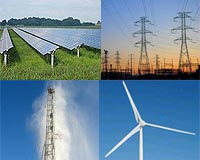 |
Kona, Hawaii (UPI) Dec 14, 2009 The world's first solar thermal plant using proprietary MicroCSP solar panels opened at the Natural Energy Laboratory of Hawaii in a major new response to the state's clean energy initiative. The thermal energy project spans 3.8 acres in the Kona desert and features 1,000 of the solar panels, the first of their kind, Hawaii-based Sopogy Inc. said. Through the use of mirrors and optics and an integrated sun tracker, the company claims the panels achieve higher efficiencies than conventional solar panels and are good at gathering energy even in the cloudiest of conditions. Solar energy is attracting funding and support worldwide amid a scramble for clean energy. As the panels' manufacturer, Sopogy is poised to replace the "chaotic" solar power installations worldwide with its branded product. Sopogy has projects operating in Idaho, California, Hawaii and several more across Europe, the Middle East and Asia. However, many of Sopogy's customers are using the systems as a competitive advantage and have intentionally kept their projects confidential. Analysts said several factors supported upgrading of conventional solar panels with more efficient and versatile devices that respond to familiar challenges, such as poor sunlight or fragility and unreliability of the equipment. Sopogy's branded system also uses a thermal energy storage buffer, the first of its kind, that allows energy to be produced during cloudy periods. The buffer can also transfer energy produced during the day to evening hours. Sopogy named the project, "Holaniku at Keahole Point" to add local color and to reflect the diversity of the technology's uses. The Hawaiian term stands for a location that has everything required for self-sufficiency. Sopogy also believes it is on to an all-round winner with the MicroCSP technology applied in solar power systems. "MicroCSP is an achievement in rugged, modular and cost-effective solar thermal technology," said Darren T. Kimura, the company's president and CEO. Kimura said the completion and demonstration of the 2 megawatt solar thermal project is an important first step toward widening its usage across the world. Sopogy's MicroCSP technologies are being used in such diverse applications as process heat, solar air conditioning, rooftop deployment and power generation. The Hawaii Clean Energy Initiative has attracted the attention of the renewable energy industry. Sopogy and its local solar project development partner Keahole Solar Power plan to bring 30 megawatts of MicroCSP power to the state by 2015. Analysts said competitive pricing of Sopogy's systems would be crucial to establishing the company into solar thermal energy markets with less cash than Europe's industrial countries or oil-rich states experimenting with energy diversification. Share This Article With Planet Earth
Related Links All About Solar Energy at SolarDaily.com
 Clean energy to grow into 1.6 trillion euros industry: WWF
Clean energy to grow into 1.6 trillion euros industry: WWFGeneva (AFP) Dec 11, 2009 The clean energy technology sector will grow into a 1.6 trillion-euro (2.4 trillion-dollar) industry by 2020, becoming the third largest industrial sector after automobiles and electronics, WWF said Friday. The clean energy industry, which includes wind energy infrastructure, insulation, solar panels and bio-ethanol treatment production, generated 630 billion euros in revenues in 2007, a sum ... read more |
|
| The content herein, unless otherwise known to be public domain, are Copyright 1995-2009 - SpaceDaily. AFP and UPI Wire Stories are copyright Agence France-Presse and United Press International. ESA Portal Reports are copyright European Space Agency. All NASA sourced material is public domain. Additional copyrights may apply in whole or part to other bona fide parties. Advertising does not imply endorsement,agreement or approval of any opinions, statements or information provided by SpaceDaily on any Web page published or hosted by SpaceDaily. Privacy Statement |